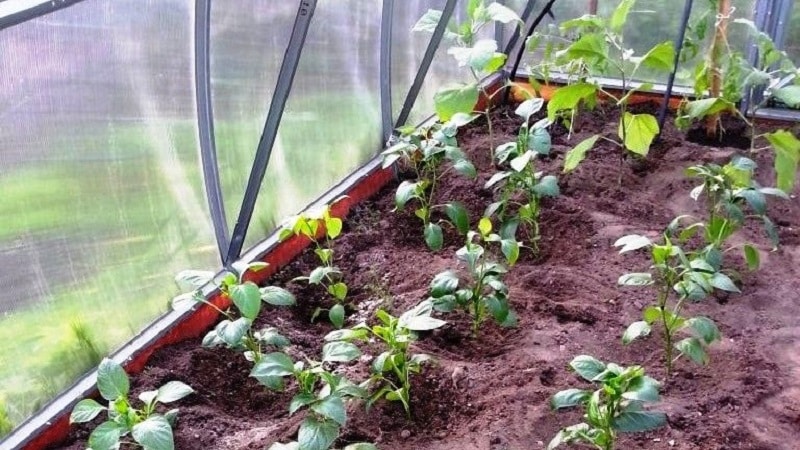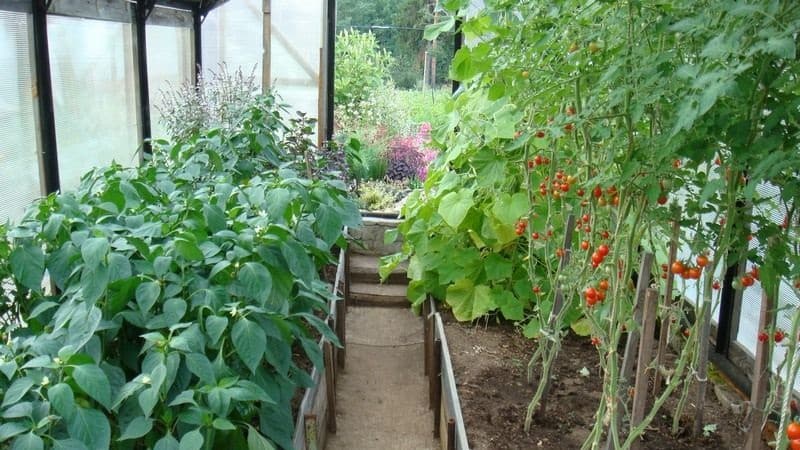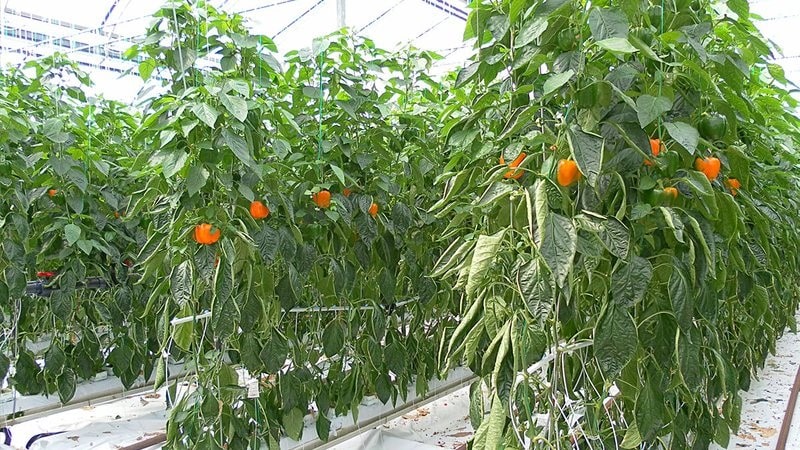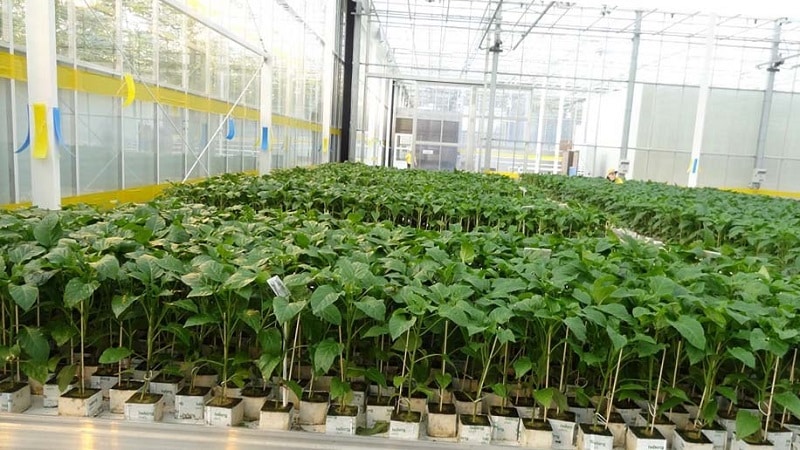What is the best way to plant peppers in a greenhouse: rules for a good neighborhood for a good harvest
Owners of small garden plots are often forced to compact vegetable plantings to save space. How will the pepper react to its neighbors in the garden and what plants planted nearby will only benefit it? We will reveal all the secrets of mixed plantings and alternating crops for a good pepper harvest in this article.
Basic principles of mixed plantings
It is impossible to grow a rich harvest in the limited space of a greenhouse without proper crop rotation and rational use of the sown area. To save space in the beds, mixed plantings of various crops are organized.
How comfortable vegetables will feel depends on agricultural technology, and not least on neighboring plants.
When planning beds, it is recommended to take into account the following principles of crop compatibility:
- plants of the same family are not planted next to each other - there will be many pests;
- Crops with the same nutritional needs do not grow together - this gives rise to competition and impoverishes the soil;
- tall plants shade short ones, so it is convenient to combine light-loving and shade-tolerant species;
- the root systems of companions should be at different depths;
- Plants in the same bed should have approximately the same moisture needs.

What is the best way to plant peppers in a greenhouse?
Let's take a closer look at how to form mixed beds of pepper and other crops.
Good neighbors
The vegetable gets along peacefully with the following plants:
- Spicy herbs: basil, thyme, coriander, marjoram. Planting these herbs improves the taste of the fruit.
- Green vegetables: lettuce, spinach. Greenery covers the soil and protects from excessive evaporation of moisture. Harvesting leafy vegetables early frees up space for peppers to develop further.
- Onions and garlic, which, thanks to phytoncides, prevent the appearance of diseases and parasites.
- Carrots that repel pests.
- Bush beans that enrich the soil with nitrogen.
- Radish.
- White cabbage and cauliflower.
Advice. Companion plants are planted between rows or along the edges of the bed. For convenience, the distance between pepper bushes is left at least 40 cm.

Bad neighborhood
Incorrectly chosen accompanying plants can inhibit pepper seedlings or themselves suffer from its effects.
The following cultures have a negative impact:
- Fennel is a very aromatic herb. With the secretions of essential oils it can suppress almost all plants near it.
- Dill. It spreads quickly throughout the beds and serves as an excellent refuge for aphids and other pests.
- Beet, which quickly wins the fight for sunlight and nutrients.
- Brussels sprouts and kohlrabi – active competitors for moisture.
- climbing plants (beans, peas), which can use pepper bushes as support and ultimately “strangle” them.
Root secretions from peppers, like other nightshades, are harmful to zucchini, squash, and pumpkin. Therefore, it is better to place beds with these vegetables further away.
Tomatoes, cucumbers and eggplants next to peppers
Building a greenhouse is an expensive undertaking, so you want to use the resulting space to the maximum benefit.
In this regard, novice vegetable growers often have a question: Is it possible to plant tomatoes, cucumbers and eggplants next to peppers in the same greenhouse?
By following simple recommendations, it is quite possible to combine plantings.
Dividing the greenhouse into zones will help achieve better results when growing different vegetables. The simplest method is to separate the beds with paths and hang film curtains.
Tomatoes
The growing conditions for the two crops are slightly different: tomatoes require ventilation, while peppers do not tolerate drafts.
When planting in one greenhouse, peppers are placed closer to the walls, and the bushes tomatoes – closer to the paths, ensuring a distance between crops of at least 1 m. This way the plants will not oppress each other and conflict over nutrients and sunlight.

Eggplant
According to the conditions of detention eggplant - an ideal neighbor. Both species are heat- and moisture-loving, equally afraid of cold and drafts.
However, eggplants require a little more heat and light, so it is better to plant them on the south side of the greenhouse.
cucumbers
Cucumbers and peppers are neutral in relation to each other. Both cultures love moisture and warmth.
Cucumber vines grow rapidly, so it is necessary to leave a large space between plantings. Pepper seedlings are planted along the walls, and cucumber seedlings are planted closer to the paths or along the central row.
Important! Tomatoes, eggplants, peppers and cucumbers are susceptible to the same diseases. In the case of joint plantings, special attention must be paid to pre-sowing disinfection of soil, greenhouses and seeds.
Neighborhood rules for bitter varieties
Sweet and hot varieties should not be planted side by side, otherwise cross-pollination will occur and pods with bitterness will grow on the sweet pepper bushes.
The distance between the beds should be at least 30 m. If the size of the plot is limited, you can plant tall plants (for example, tomatoes) between the beds. This will reduce the risk of cross-pollination.
You cannot plant sweet and hot vegetables in the same greenhouse.
Bitter pepper It is permissible to plant next to tomatoes or eggplants. Their pollen is incompatible, so all vegetables will remain with their own characteristic taste.

Alternation of crops
Crop rotation, or alternation of crops, is a necessary measure to maintain soil fertility, reduce the number of weeds on the site, and prevent the accumulation of foci of diseases and parasites.
The crop turnover is usually 2-3 years.
Successful predecessors
Peppers will grow healthier and produce a larger harvest in the beds where they previously grew:
This is due to the fact that the organic matter added to the listed crops has time to rot well. The soil becomes loose and contains the optimal amount of nutrients for the pepper.
After which peppers are not planted
After tomatoes, eggplants, potatoes and other plants belonging to the nightshade family, pepper grows reluctantly.
The explanation for this is simple: all these crops take the same nutrition from the soil and are susceptible to the same diseases and pests.

What to plant in the greenhouse next year
In the garden where peppers grew, root vegetables will do well: radishes, carrots, beets. After bell peppers, legumes, cabbage, onions, celery, spinach, and various types of salads successfully bear fruit.
Pepper is a bad predecessor for pumpkin, zucchini, and squash. Its roots secrete specific substances that are harmful to pumpkin plants.
Results
When growing peppers indoors, mixed plantings are practiced to save space. The plant coexists peacefully with basil, thyme and other herbs. Good neighbors are green vegetables, garlic, onions, carrots. Combining beets, dill, fennel, and peas in the same bed gives poor results.
With the right agricultural technology, it is not difficult to grow peppers, eggplants, tomatoes and cucumbers in one greenhouse. It is useful to plant vegetables after cucumbers, zucchini, carrots, and onions. Pepper is a good precursor for root vegetables and leafy vegetables. Careful planting planning, even in a limited area, will bring a rich harvest.